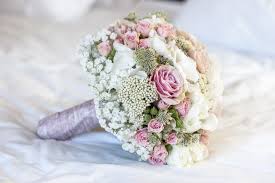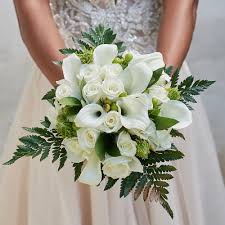Bridal bouquets hold a special place in the world of weddings, symbolizing love, beauty, and the blooming of a new chapter in a couple’s life. These carefully arranged clusters of flowers are not only exquisite accessories but also meaningful elements that add a touch of elegance and personal style to a bride’s ensemble. From classic cascading arrangements to modern and minimalist designs, bridal bouquets come in a myriad of styles, colors, and fragrances, making them a captivating focal point in wedding celebrations.
The tradition of carrying a bouquet down the aisle dates back centuries, originating from ancient times when brides would carry herbs and spices to ward off evil spirits. Over time, this practice evolved, and the bouquet became a stunning manifestation of the bride’s personality, wedding theme, and the sentiments she wishes to convey on her special day.
One of the most enchanting aspects of bridal bouquets is their ability to reflect the bride’s individuality. Every flower, whether it be a delicate rose, a vibrant peony, or a graceful lily, possesses its own unique symbolism and characteristics. Brides can choose blooms that resonate with their personalities, such as the romantic and timeless roses or the wild and free-spirited daisies. By carefully selecting flowers that hold personal significance, a bride can infuse her bouquet with sentimental value, creating a meaningful connection between her and her floral arrangement.
Beyond the choice of flowers, the style and arrangement of a bridal bouquet play a crucial role in enhancing its beauty. A traditional cascading bouquet, with its trailing greenery and blooms, exudes a sense of timeless romance and grandeur. For brides seeking a more contemporary look, a compact posy bouquet featuring tightly clustered flowers offers a modern and sleek aesthetic. Additionally, hand-tied bouquets with loose stems and a natural arrangement give off an effortlessly elegant vibe, perfect for bohemian or rustic-themed weddings.
The color palette of a bridal bouquet is another vital element that sets the tone for the entire wedding. Soft pastels like blush pinks, pale blues, and lavender evoke a sense of delicacy and femininity, while bold and vibrant hues such as fiery oranges, deep reds, and rich purples make a striking statement. Some brides opt for monochromatic bouquets, using various shades of a single color to create a harmonious and refined look, while others choose contrasting colors to add drama and visual interest.
While flowers are the stars of the show, it’s worth noting that foliage and greenery play an equally important role in creating a captivating bridal bouquet. Eucalyptus, ferns, ivy, and other lush greens provide texture, depth, and a touch of nature to the arrangement. They also act as a complement to the flowers, enhancing their beauty and providing a balanced composition.
In recent years, the concept of sustainability has made its way into the world of weddings, and bridal bouquets are no exception. Brides now have the option to choose eco-friendly and ethically sourced flowers and foliage for their bouquets. Locally grown and seasonal flowers, as well as using potted plants or dried flowers, are gaining popularity as eco-conscious alternatives. This shift towards sustainability allows brides to celebrate their special day while respecting the environment.
Bridal bouquets not only adorn the hands of brides but also become cherished mementos of their wedding day. Many brides choose to preserve their bouquets, either by drying the flowers or having them professionally pressed and framed. By preserving these precious blooms, brides can cherish the memories and emotions associated with their bouquet for years to come.
In addition, bridal bouquets are much more than just a beautiful accessory; they are a reflection of a bride’s personality, style, and emotions. These carefully crafted arrangements of flowers, foliage, and greenery symbolize the love, beauty, and new beginnings that weddings represent. With their exquisite designs, captivating colors, and fragrant aromas, bridal bouquets add a touch of elegance and grace to the celebration of love, making them an essential element in every bride’s journey down the aisle.
Read Also: Fire as a Tool in Habitat Management
Types of Bridal Bouquets

When it comes to bridal bouquets, the options are as diverse as the brides themselves. From classic and traditional to modern and avant-garde, there are numerous types of bouquets to suit every bride’s taste and wedding style. Let’s delve into some popular types of bridal bouquets that have become iconic symbols of beauty and elegance.
Round Bouquet: The round bouquet, also known as a posy or nosegay, is a timeless and versatile choice. It features a tightly arranged cluster of flowers, usually in a spherical shape. This bouquet style is perfect for brides who prefer a compact and structured arrangement. Roses, peonies, hydrangeas, and tulips are popular blooms for round bouquets.
Cascade Bouquet: This dramatic and romantic bouquet is characterized by a waterfall-like arrangement, with flowers flowing downward in a cascading fashion. It often includes a mix of trailing flowers, such as orchids, ivy, and lilies, along with focal blooms. Cascade bouquets exude elegance and are well-suited for formal weddings.
Hand-Tied Bouquet: The hand-tied bouquet presents a natural and effortless look. It typically consists of loosely gathered flowers and greenery, wrapped in ribbon or twine. This style mimics a fresh-picked bouquet and suits outdoor, rustic, or bohemian-themed weddings. It allows for a more organic and unstructured appearance, often featuring wildflowers, daisies, or baby’s breath.
Composite Bouquet: The composite bouquet, also known as a glamelia, is a unique and labor-intensive arrangement. It is created by meticulously crafting individual petals to form a large, singular flower. This technique often involves using rose petals to construct a large, central bloom that resembles a magnified flower. The composite bouquet makes a bold statement and is perfect for brides seeking a one-of-a-kind floral accessory.
Posy Bouquet: A posy bouquet is a small and delicate arrangement typically composed of a single type of flower, such as roses or lilies. It is compact in size and easy to hold, making it an ideal choice for bridesmaids or a bride who prefers a minimalist approach. Posy bouquets can also serve as a charming complement to a larger bridal bouquet.
Pomander Bouquet: The pomander bouquet, also known as a kissing ball, is a whimsical and unconventional option. It features a round ball of flowers suspended from a ribbon or decorative string. This bouquet style is often carried by flower girls or bridesmaids and adds a playful touch to the wedding procession.
Crescent Bouquet: The crescent bouquet is a crescent-shaped arrangement that exudes elegance and sophistication. It is created by arranging flowers in an arching shape, forming a gentle curve. The crescent bouquet can be small and compact or elongated and dramatic, depending on the bride’s preference. Calla lilies, orchids, or roses are commonly used in this bouquet style.
Composite Cascade Bouquet: This luxurious and opulent bouquet combines the features of the composite and cascade bouquets. It showcases a cascading arrangement composed of individually crafted flower petals. The composite cascade bouquet creates a breathtaking display of floral artistry, making it a statement piece for a glamorous and extravagant wedding.
Biedermeier Bouquet: The Biedermeier bouquet originated in 19th-century Europe and is characterized by concentric circles of different flowers. Each layer represents a specific type of flower, creating a distinctive and symmetrical pattern. This bouquet style offers a visually striking and structured look, making it a popular choice for modern brides.
When selecting a bridal bouquet, it’s essential to consider your wedding theme. As you can see, the world of bridal bouquets offers an array of options to suit every bride’s taste, style, and wedding vision. Whether you prefer a classic round bouquet, a cascading masterpiece, or a contemporary and unconventional design, there is a bouquet type that will beautifully complement your wedding day and make a lasting impression.
Read Also: Tomatoes Farming: 9 Factors that Hinders High Yield for Profit
Uses of Bridal Bouquets

Bridal bouquets are not only stunning accessories for brides to carry down the aisle but also serve various other purposes throughout the wedding celebration. Their beauty and versatility make them a valuable element that adds charm and elegance to different aspects of the wedding festivities. Let’s explore some of the diverse uses of bridal bouquets beyond their traditional role.
Bridal Portraits: Bridal bouquets are often featured prominently in bridal portraits, capturing the beauty and essence of the bride. These portraits serve as cherished keepsakes, showcasing the bride’s stunning ensemble and the carefully selected bouquet. The bouquet becomes a focal point in these photographs, adding an extra touch of elegance and personality.
Bridesmaid Bouquets: Bridesmaid bouquets are smaller versions of the bridal bouquet, designed to complement the bride’s arrangement while still reflecting the overall wedding theme. These bouquets are carried by bridesmaids during the wedding ceremony, creating a cohesive and harmonious look among the bridal party. Bridesmaid bouquets can be replicas of the bridal bouquet or feature similar flowers and colors to maintain a cohesive aesthetic.
Reception Decor: Once the ceremony is over, bridal bouquets can be repurposed as stunning floral decor at the wedding reception. Placing the bouquets in vases or on tables as centerpieces adds a touch of elegance and continuity to the overall decor. The fragrance and beauty of the flowers continue to enchant guests as they celebrate and enjoy the reception festivities.
Cake Decoration: Bridal bouquets can be creatively incorporated into the wedding cake design. Small blooms or individual flowers from the bridal bouquet can adorn the tiers of the cake, matching the overall floral theme. This adds a cohesive and visually appealing element to the cake, elevating its aesthetics and tying it in with the rest of the wedding decor.
Tossing Bouquet: Some brides choose to have a separate bouquet, known as the tossing bouquet, specifically designed for the traditional bouquet toss. During the reception, the bride tosses the tossing bouquet to a group of single women, symbolizing the passing on of her good fortune in finding love. This allows the bride to keep her original bridal bouquet intact as a cherished memento while still participating in this fun and lighthearted tradition.
Bridal Party Thank You Gifts: Bridal bouquets can serve as thoughtful and beautiful gifts for the bridal party. After the wedding celebrations, the bride can present each bridesmaid with her bouquet as a token of appreciation for their support and participation in the wedding. This gesture allows the bridesmaids to take home a piece of the wedding day and serves as a lasting reminder of their role in the bride’s journey.
Preservation and Keepsake: Many brides choose to preserve their bridal bouquets as treasured keepsakes. By drying the flowers or having them professionally preserved, the bouquet can be displayed or stored as a memento of the special day. Preserving the bouquet allows the bride to relive the emotions and memories associated with her wedding whenever she sees it.
Bridal bouquets hold significance and serve multiple purposes throughout the wedding celebration. Beyond being a beautiful accessory for the bride, they become an integral part of capturing memories, enhancing the decor, and expressing gratitude to loved ones. The versatility of bridal bouquets ensures that their elegance and charm continue to radiate throughout the entire wedding journey.
Read Also: Embracing the Circular Economy for a Thriving Future
